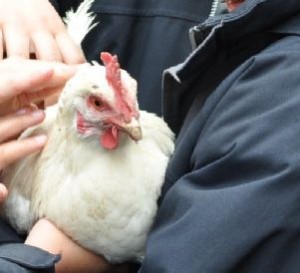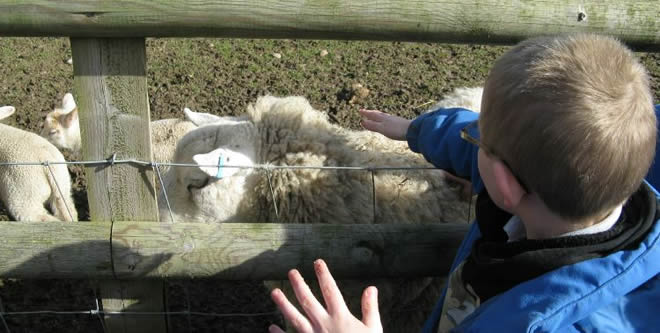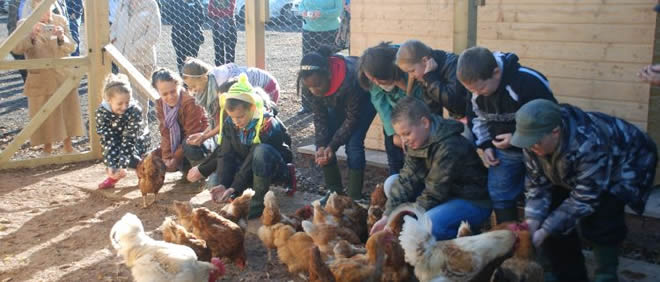THE CATTLE
- This is essentially a dairy unit i.e. cows producing milk with their calves being raised for meat or milk production.
- A cow must have a calf every year if she is to continue producing milk.
- Peter currently milks about 200 cows twice a day.
- In total there are around 350 cattle – cows, calves, heifers (teenagers) and bullocks, here or at Chapmans Hill Farm.
- Many of the calves live in special calf hutches.
- The dairy cows are mainly black and white Holstein Friesians with a few brown & white Dairy Shorthorns.
- They are identified by ear tags and numbers branded on their rump to identify them in the parlour.
- Some of the cows wear collars around their necks this is similar to a human fitbit.
- Most of the cows are artificially inseminated (AI) to continue breeding pedigree animals. Crossbreed and male calves are sold to Peters brother or other local farmers to be raised as beef animals.
- The cattle are housed indoors for most of the year . During the summer months dry cows are grazed outdoors for around 3 weeks prior to calving.
- There are presently 5 large yards which can house cattle or be used to store straw and equipment.
The Milking Parlour
The herringbone milking parlour holds 30 cows at a time with 15 on each side. Milking starts from 4.30am and again at 3.00pm. It takes around 3.5 hours to milk all the cows in each milking session plus 30 minutes to clear up, during milking the calves are fed.
The Milk Tank
There are 2 milk vats in the dairy and are collected every day by Arla Foods transport. The large vat (milk tank) holds 20,000 litres and the smaller one holds 6,000 litres and is used as a spare or back up tank. The milk must be stored at less than 5 degrees Celsius. Peter receives about 32p base price for each litre of milk at the moment, this price can go up and down throughout the year. (Less than a quarter of the end product price for milk comes back to the farm).On average the farm is sending around 6,000litres to Arla foods.

THE SHEEP
- Few tame ewes and are kept for the children to feed and observe.
- Lambing time is around late February to March and the sheep are sheared in late May , Their wool normally goes for sale through the Wool Marketing Board.
- All lambs have been sold for meat at the local Market .
- The increased size of the dairy herd also meant that there are no buildings in which to house a large flock during lambing time.
- Peter has built a lambing and winter shelter for the school sheep behind the pig sty as our winters seem to be getting wetter and more severe.
- The sheep have their own paddock by the reed beds and also have access around the back of the classroom. They also can be seen from our large classroom windows.
- The children can feed the sheep safely without entering the field, whilst standing on a hard surface area or grass area (weather dependant).
- Our sheep are a wonderful example of Herbivores i.e. animals who do not have canine teeth and must have a vegetarian diet.
********************
THE PIGS
We have 2 female pigs (Gilts) who live in a purpose built sty close to the classroom.
Both of the pigs are large Whites.
The pigs are kept for educational purposes and are used to promote farm to fork for ks2 science.
Pigs are the cleanest animal on the farm believe it or not !
The children can see, but not feed them as pigs have up to 28 teeth! from a very young age ,which are very sharp .Viewing the pigs is optional. If visitors prefer not to meet the pigs in their sty this will be respected.
********************
THE POULTRY
- One of the hands on activity is to feed the hens.
- New hen houses have been built in the summer 2023 and provide a sheltered area in wet weather to feed and look at the hens.
- 24 or so free range birds lay from the spring through until the autumn.
- Each pen has a cockerel so the eggs should be fertile and could be hatched out as chicks.
- We keep some brown hens (derived from the Rhode Island Red) but also have a range of other good egg-laying breeds. The children can then observe their colours and characteristics.
- In winter the decreasing light levels and cold weather tend to stop the older birds from laying so we buy in some young pullets and egg production increases significantly after February.
- However a hen can only produce a maximum of one egg per day.




